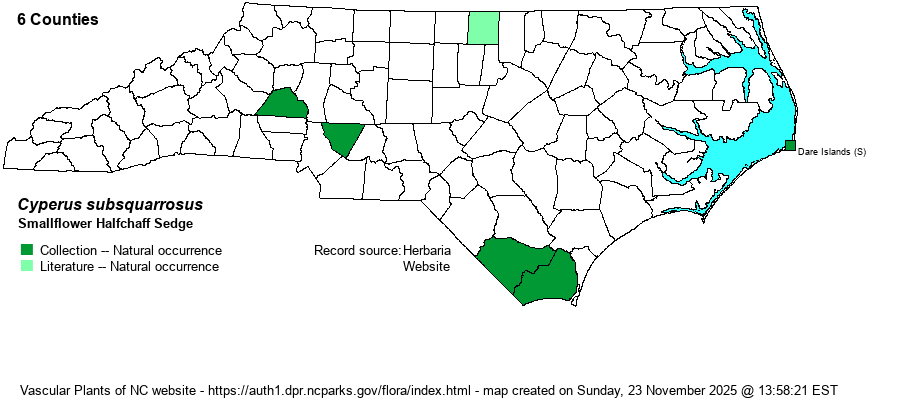| Section 5 » Family Cyperaceae |
Show/Hide Synonym
| taxonName | relationship | relatedTaxonName | relatedTaxonRefText | relComments |
|---|
|
| Cyperus subsquarrosus | = | Lipocarpha micrantha | Flora of North America (1993b, 1997, 2000, 2002a, 2002b, 2003a, 2004b, 2005, 2006a, 2006b, 2006c, 2007a, 2009, 2010) | | | Cyperus subsquarrosus | = | Lipocarpha micrantha | | | | Cyperus subsquarrosus | = | Lipocarpha micrantha | Wunderlin & Hansen Flora of Florida (3) | | | Cyperus subsquarrosus | = | Lipocarpha micrantha | Goetghebeur & Van den Borre (1989)=V. | | | Cyperus subsquarrosus | = | Lipocarpha micrantha | | | | Cyperus subsquarrosus | = | Lipocarpha micrantha | Flora of Virginia | | | Cyperus subsquarrosus | = | Lipocarpha micrantha | Goetghebeur & Van den Borre (1989)=V. | | | Cyperus subsquarrosus | = | Hemicarpha micrantha | Fernald (1950) | | | Cyperus subsquarrosus | = | Hemicarpha micrantha | Godfrey and Wooten (1979, 1981) | | | Cyperus subsquarrosus | = | Hemicarpha micrantha | Radford, Ahles, and Bell (1968) | | | Cyperus subsquarrosus | = | Hemicarpha micrantha | Small (1933, 1938) | | | Cyperus subsquarrosus | = | Hemicarpha micrantha var. micrantha | Gleason and Cronquist (1991) | | | Cyperus subsquarrosus | = | Hemicarpha micrantha var. minor | Gleason (1952) | | | Cyperus subsquarrosus | < | Hemicarpha micrantha | Kartesz (1999) | | | Source: Weakley's Flora |
|
| Author | (Muhlenberg) Bauters | |
| Distribution | Mainly the outer Coastal Plain. Six locations known for NC: drawdown shores of Waccamaw River (Brunswick and Columbus counties), "saltmarsh at Hatteras" (Dare County), shore of Lake Norman (Catawba County), shore of Lake Fisher (Cabarrus County), and shore of Hyco Lake (Person County).
ME to Ont. and MN, south to southern FL and TX; also tropical America. Very local and sporadic in much of its range. | |
| Abundance | Formerly rare and local near the coast, and extremely rare inland. Most records are several decades old; however, Eric Ungberg has recently re-discovered the species along the Waccamaw River and in Person County (photos on iNaturalist) in 2022. The editors also recommend a State Status of SC-V, as the species is no longer historical; the legal State Status is SC-H, as until recently the species was considered as Historical in NC. | |
| Habitat | Sandy drawdown zone of blackwater river; brackish marsh; shores of impoundment lakes. Elsewhere in its wide range, most often found on exposed shores of ponds and lakes. | |
| Phenology | Flowering and fruiting July-Sept. | |
| Identification | Smallflower Halfchaff Sedge is a very small, tufted plant that elsewhere may reach 9 inches tall, but in NC no more than 4 inches. One to three spikes are bunched together at the ends of slender stems, resembling tiny pine cones. | |
| Taxonomic Comments | A long-used synonym is Hemicarpha micrantha; another more recent one is Lipocarpha micrantha.
The genus Cyperus is mostly tropical and warm-temperate in distribution; thus, in NC it is much commoner in the Coastal Plain than in the Mountains and Piedmont. Most species have 1-few flowering stems (culms) from grasslike basal leaves, plus a few stem leaves. At the summit is an inflorescence of very open and branched, or tightly packed, spikes, varying among species from brown to golden brown to straw-color to reddish. The arrangement of the spikelets is important, whether like a hand (digitate) or in paired or alternate rows (pinnate); as is the shape of the achene (seed), whether bi-convex in cross-section or triangular. As a group, Cyperus tends to be weedy and readily enters disturbed ground; this is true for many natives as well as all the aliens. In recent years, following DNA research, the genus has incorporated several genera that in RAB (1968) or other manuals were separate: Hemicarpha, Lipocarpha, and Kyllinga. | |
| Other Common Name(s) | Dwarf Bulrush | |
| State Rank | S1 | |
| Global Rank | G5 | |
| State Status | SC-H [SC-V] | |
| US Status | | |
| USACE-agcp | | |
| USACE-emp | | |

